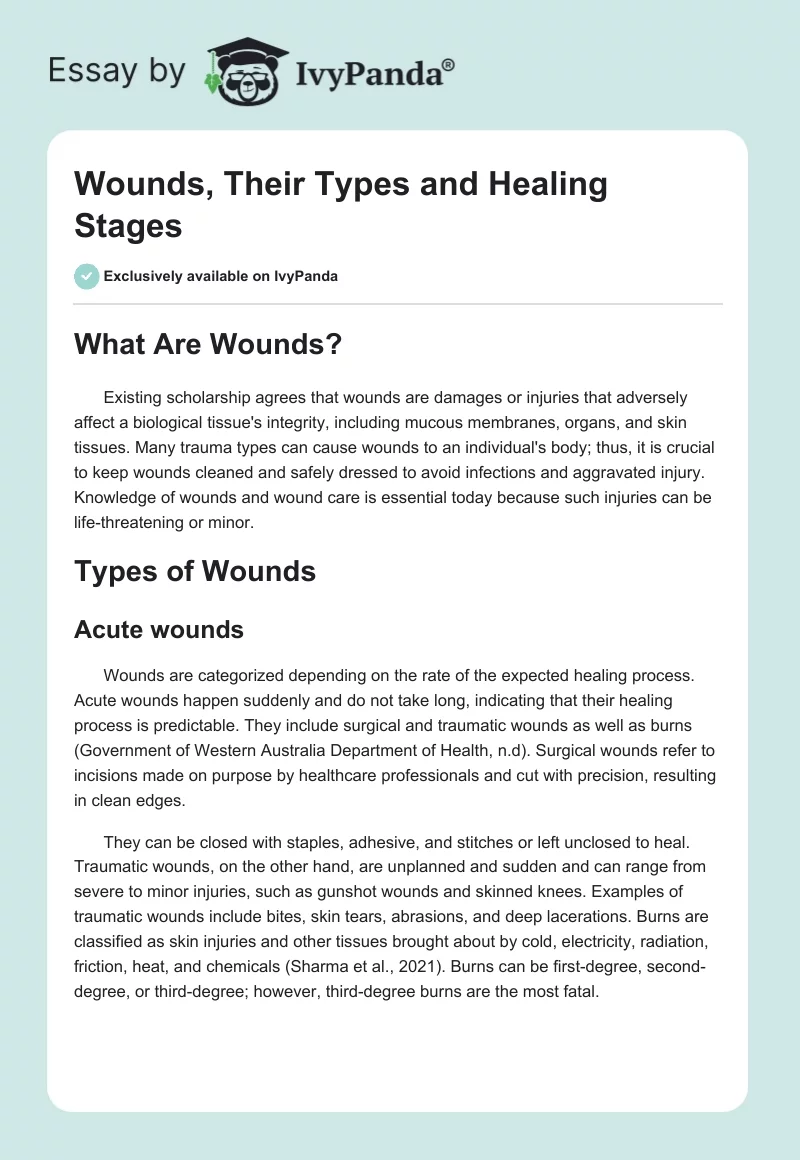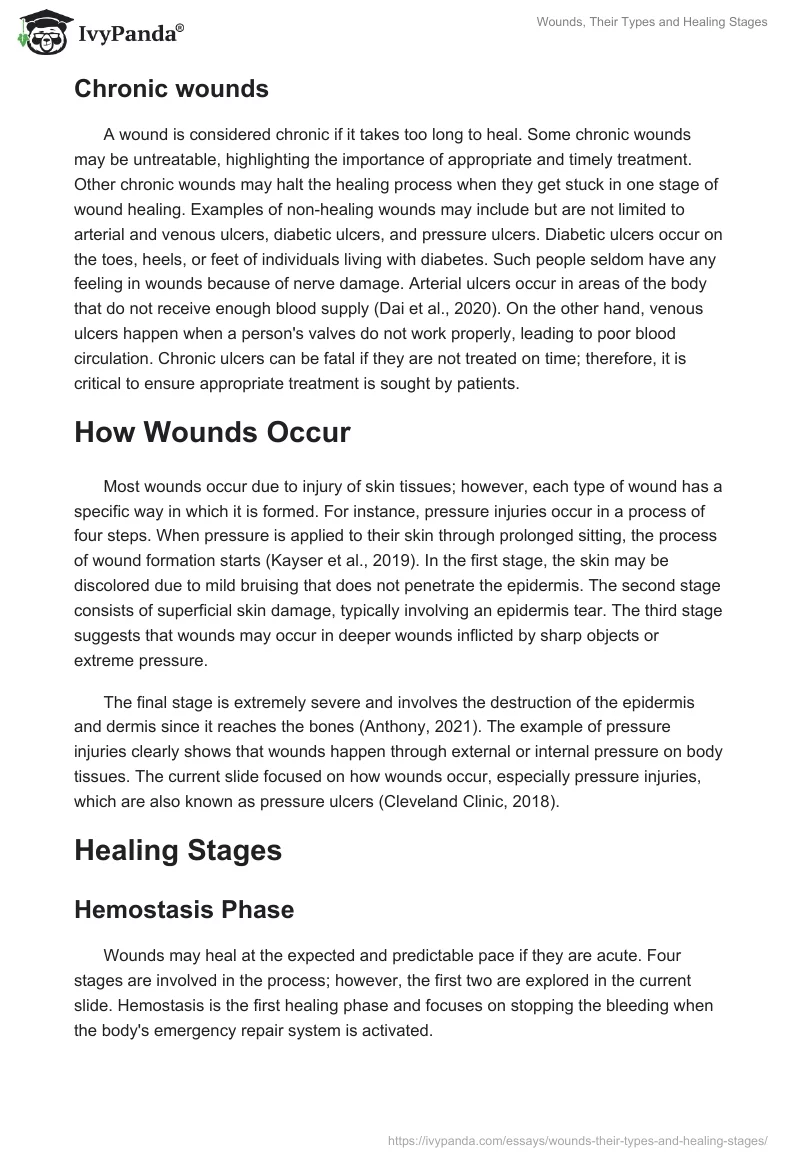What Are Wounds?
Existing scholarship agrees that wounds are damages or injuries that adversely affect a biological tissue’s integrity, including mucous membranes, organs, and skin tissues. Many trauma types can cause wounds to an individual’s body; thus, it is crucial to keep wounds cleaned and safely dressed to avoid infections and aggravated injury. Knowledge of wounds and wound care is essential today because such injuries can be life-threatening or minor.
Types of Wounds
Acute wounds
Wounds are categorized depending on the rate of the expected healing process. Acute wounds happen suddenly and do not take long, indicating that their healing process is predictable. They include surgical and traumatic wounds as well as burns (Government of Western Australia Department of Health, n.d). Surgical wounds refer to incisions made on purpose by healthcare professionals and cut with precision, resulting in clean edges.
They can be closed with staples, adhesive, and stitches or left unclosed to heal. Traumatic wounds, on the other hand, are unplanned and sudden and can range from severe to minor injuries, such as gunshot wounds and skinned knees. Examples of traumatic wounds include bites, skin tears, abrasions, and deep lacerations. Burns are classified as skin injuries and other tissues brought about by cold, electricity, radiation, friction, heat, and chemicals (Sharma et al., 2021). Burns can be first-degree, second-degree, or third-degree; however, third-degree burns are the most fatal.
Chronic wounds
A wound is considered chronic if it takes too long to heal. Some chronic wounds may be untreatable, highlighting the importance of appropriate and timely treatment. Other chronic wounds may halt the healing process when they get stuck in one stage of wound healing. Examples of non-healing wounds may include but are not limited to arterial and venous ulcers, diabetic ulcers, and pressure ulcers. Diabetic ulcers occur on the toes, heels, or feet of individuals living with diabetes. Such people seldom have any feeling in wounds because of nerve damage. Arterial ulcers occur in areas of the body that do not receive enough blood supply (Dai et al., 2020). On the other hand, venous ulcers happen when a person’s valves do not work properly, leading to poor blood circulation. Chronic ulcers can be fatal if they are not treated on time; therefore, it is critical to ensure appropriate treatment is sought by patients.
How Wounds Occur
Most wounds occur due to injury of skin tissues; however, each type of wound has a specific way in which it is formed. For instance, pressure injuries occur in a process of four steps. When pressure is applied to their skin through prolonged sitting, the process of wound formation starts (Kayser et al., 2019). In the first stage, the skin may be discolored due to mild bruising that does not penetrate the epidermis. The second stage consists of superficial skin damage, typically involving an epidermis tear. The third stage suggests that wounds may occur in deeper wounds inflicted by sharp objects or extreme pressure.
The final stage is extremely severe and involves the destruction of the epidermis and dermis since it reaches the bones (Anthony, 2021). The example of pressure injuries clearly shows that wounds happen through external or internal pressure on body tissues. The current slide focused on how wounds occur, especially pressure injuries, which are also known as pressure ulcers (Cleveland Clinic, 2018).
Healing Stages
Hemostasis Phase
Wounds may heal at the expected and predictable pace if they are acute. Four stages are involved in the process; however, the first two are explored in the current slide. Hemostasis is the first healing phase and focuses on stopping the bleeding when the body’s emergency repair system is activated.
Defensive Phase
The second step is the defensive phase, which primarily destroys bacteria and removes debris from the wound (Wilkinson & Hardman, 2020). In the current slide, the defensive stage is also called the inflammatory phase. Wound healing goes through different phases, with each stage being essential to effective tissue restoration. The following slide explores the remaining stages of the healing process, which include the proliferative and maturation phases.
Proliferative Phase
The wound healing process consists of two more processes that ensure the effects of an injury are reversed. The third stage, which involves the proliferative phase, fills the wound, helps in margin contraction, and covers the injury (Wilkinson & Hardman, 2020).
Maturation Phase
Finally, the maturation phase ensures that new tissues gain flexibility and strength by reorganizing fibers and remodeling. Extreme care should be taken to ensure factors that may hinder the healing process are avoided by patients for faster recovery.
References
Anthony, K. (2021). Pressure ulcer(bedsore) stages. Healthline. Web.
Cleveland Clinic. (2018). Pressure injuries(bedsores). Web.
Dai, C., Shih, S., & Khachemoune, A. (2020). Skin substitutes for acute and chronic wound healing: An updated review. Journal of Dermatological Treatment, 31(6), 639-648. Web.
Government of Western Australia Department of Health. (n.d.). Wounds. Web.
Kayser, S. A., VanGilder, C. A., & Lachenbruch, C. (2019). Predictors of superficial and severe hospital-acquired pressure injuries: A cross-sectional study using the International Pressure Ulcer Prevalence™ survey. International Journal of Nursing Studies, 89, 46-52. Web.
Sharma, A., Khanna, S., Kaur, G., & Singh, I. (2021). Medicinal plants and their components for wound healing applications. Future Journal of Pharmaceutical Sciences, 7(1), 1-13. Web.
Wilkinson, H. N., & Hardman, M. J. (2020). Wound healing: Cellular mechanisms and pathological outcomes. Open biology, 10(9), 1-14. Web.
Zorii, A. (n.d.). Children injury [iStock]. Getty Images. Web.


